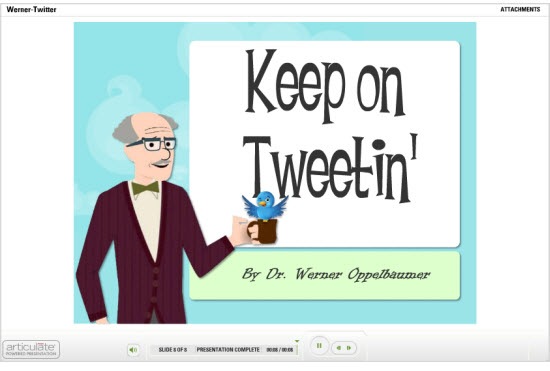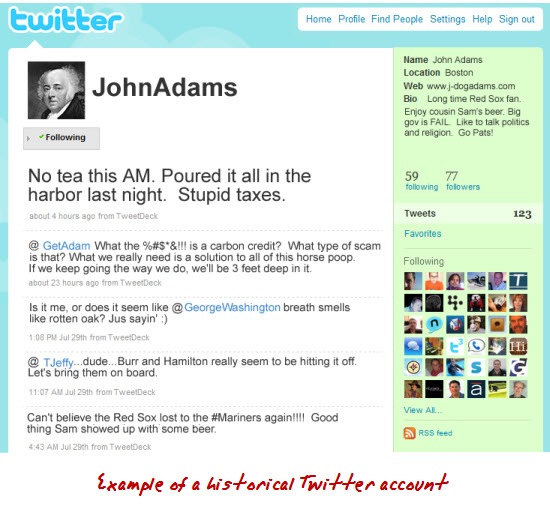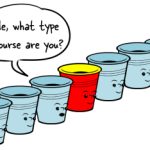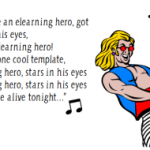
Twitter’s all the rage. Some people love it. Some people hate it. But many people really don’t know much about it or don’t do much with it.
I’ll have to admit, I have mixed feelings about Twitter (and much of the other social media). On one hand, I really love to play around with all of the new social media tools and am excited about what’s going on and the potential for learning. On the other hand, much of their value is exaggerated. A lot of this social media stuff can be distracting and a waste of time. But that’s not so much the fault of the social media tools as much as it is their newness and not quite knowing what to do with all of the them and the content they create.
For me it’s all about context. I am bombarded by so much info that I tend to tune out quite a bit. I like to focus on the more practical information that I can use. For example, the Articulate twitter page is a good resource for Articulate users since it provides news, tutorials, and links to helpful tips and tricks.
While I do follow people, I tend to focus on topics and keywords. This helps me get more pointed information and not be bombarded by a bored tweep who’s retweeting and posting links every 5 minutes. You know who you are. 🙂
With all that said, Twitter is a useful tool. It can also be incorporated into your elearning courses. Today I’d like to share a few ideas to whet your appetite. However before I share some tips, it’s probably a good idea to explain some Twitter basics. So I asked Dr. Werner Oppelbaumer to share some of his insights regarding Twitter.

Click here to watch Dr. Werner’s presentation.
In addition to Dr. Werner’s brilliant insights, here are some additional ideas about how to use Twitter.
Follow the Subject Matter Expert
Suppose you’re doing a course on organizational leadership. Inevitably, some learners will have questions of the subject matter expert (SME). You could incorporate a subject matter tweet that lets people ask questions or follow the SME after the course is complete. Consider it a post-course consulting tool. It also humanizes the course and makes it seem more personal, which can contribute to its perceived value.
Here’s another idea for those in the education world. Create a twitter account for a famous person who represents the topic you teach. Then have the students follow the tweets. For example, it would be fascinating to read the tweets of someone like John Adams responding to some of the debate in Washington D.C. today. Or keep the tweets in context to the historical character’s time. Perhaps you can teach about the D-Day invasion via the tweets of a soldier crossing the channel and storming the beach at Normandy. You could even include media using sites like Twitvid. What a great way to make history come alive!
Another angle is to have each student represent a historical character and then they have to tweet and follow the other student characters of the time. Based on their tweets, it would be a great way to assess their level of understanding of the subject you’re teaching.

Follow the Subject
You can assign and follow tweets via a hashtag. What you do is something like this:
I look forward to September and watching the Seattle #Seahawks play.
Someone tracking #Seahawks can now see my tweet. If you wanted people who take your course to continue the conversation or keep on top of a particular subject, then use a hashtag.
Let’s say you were teaching a course on fire safety. The hashtag could be #fs or #fire. Then anyone can track the hashtag and stay up on the latest info. Of course you want something that is both somewhat unique and short so you don’t take up all of your characters.
Once you have a course hashtag, you can use Twitter to provide additional content after the course. You can also use it to get your learners to respond and provide feedback. They could add some thoughts or tips that they learned. They could also go back to their jobs, apply the course information, and then comment on how it worked for them. This helps you make adjustments to the course content and it’s a good way to get an extra level of evaluation that’s more than the standard “smile sheet.”

Build a Community
There’s no reason why you couldn’t use Twitter to help facilitate a community of practice. The real value in social media is in community building where you’re able to connect people who share similar interests and get them to exchange ideas. And Twitter is great for that.
Have the learners use Twitter to share their thoughts. For example, instead of giving them an assessment, make the assessment their Twitter stream. They need to reflect on what they’re learning in the course and then share that with others.
Another way to get them involved is to have them share links and other information relevant to what they’ve learned. Even if the course content is proprietary, there’s no reason why they couldn’t go out and look for other thought leaders or groups in the same industry to build on what they’re learning in your course.
For example, if I were teaching on the Truth in Lending Act, I’d have them look for some news stories about lending relevant to the Truth in Lending Act. Or perhaps have them do some research on why we have a Truth in Lending Act. Or share their thoughts on what would happen if there was no Truth in Lending Act.
To build the community use hashtags or sign up for a site like Twibes whe
re you can create communities around mutual interest. Two things to consider. First, not everyone will jump on the community bandwagon. That’s fine, you only need a few enthusiastic learners. Secondly, Twitter kind of started as a microblogging tool. If you want better organized conversation it might not be the best tool to use. In that case, you could look at a chat application or a forum where you could have threaded comments. They tend to be easier to follow.
Those are just a few ways you can use Twitter. Of course, this doesn’t work for everybody. Some of you are behind corporate firewalls and don’t have access to Twitter. However, if you do have access to Twitter (or an enterprise equivalent) then these tips might come in handy. If not, then change Twitter to wiki or some other social media tool you do have access to and see if these ideas work for you.
What are some other ways that you can think of blending Twitter with your elearning courses? Share your thoughts by clicking on the comments link.
*The free Twitter icons came from Gopal Raju at ProductiveDreams.
**Dr. Werner’s avatar came from AMC’s MadMenYourself.com.
Events
Free E-Learning Resources



















0
comments